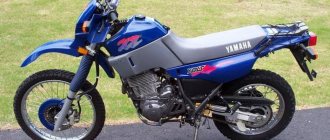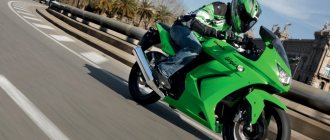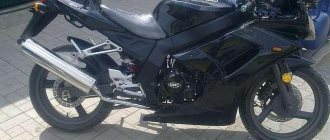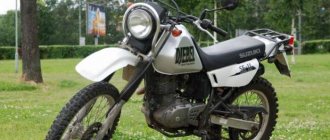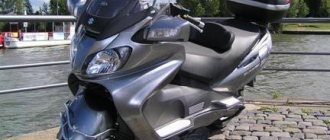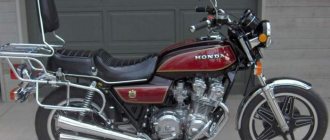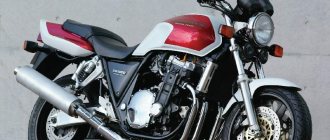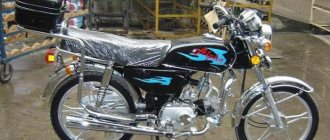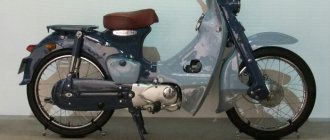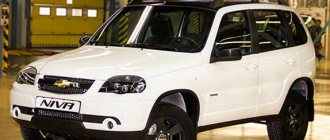Engine
The power unit was created on the basis of the 690 Duke R, released in 2010. The development was led by Josef Mindlberger, thanks to whom the LC4 received two spark plugs with individual coils, which are controlled independently of each other by the ECU and the Drive-by-Wire throttle control system. Engine output remained unchanged - 70 horsepower and 70 Nm - but fuel consumption and emissions of harmful substances were reduced by almost 10%.
The 690cc engine featured an APTC slipper clutch and balancer shaft and was similar in design to the engine introduced a few years earlier in the Duke 690R and now found in the 690 Enduro-R and 690 SMC-R.
KTM 690 R Duke motorcycle test
It's a pity. It’s a pity that I didn’t immediately start counting the looks of people passing by, looking in surprise at “my” two-wheeled vehicle. Frankly, at first it just seemed to me that those around me were amused by the disproportion of the massive helmet-wearing guy and the elegantly bright motorcycle. But, looking at the first photos, I thought that most likely they didn’t see me at all. And they look and listen only to him - a white with orange arches, warlike growling beast. KTM 690 R Duke.
Prejudice is a powerful thing. The Austrians have been producing a variety of “supermotards”, “streets” and even sportbikes for more than ten years, but in the minds of even the very two-wheeled enlightened population they remain the kings of off-road, and any piece of equipment from Mattinghofen that is not intended for mixing mud or jumping over it causes genuine surprise. However, KTM marketers and dealers are clearly aware of something similar, otherwise how can they explain the price tag of almost 600 thousand rubles. for a strange-looking “single-barreled gun”?
I admit, I am also full of prejudices, but, unlike the opinions of outside observers, they are of a slightly different nature. For example, I never liked single-cylinder engines, that is, those same “single-barrel engines” from the previous paragraph. It’s also hard for me to understand why you would put a wide all-terrain steering wheel on a device designed to be laid on its side during a “time attack” at a karting track or daily “punching through traffic jams.”
And in general, it’s kind of frivolous - this 690 R Duke. Parrot-like red arcs, the only dial in the instrument cluster of the same color, dull light bulbs...
Okay, down with the grumbling. Called himself milk mushroom - don’t say it’s tasteless. I press the starter button and am immediately surprised: the engine hardly vibrates - thanks to the balancer shaft. However, he is able to overcome only one of the troubles of single-barreled guns, but the other, namely uneven traction, is much more important!
There was no need to worry: the engine with the LC4 index pulls perfectly, with all its 70 forces and such a number of newton meters, which for 149 kilos of dry mass is beyond the eyes. Here it’s worth making a nod towards the electronic throttle and two spark plugs, each of which works according to its own map, optimizing the combustion of the fuel-air mixture.
Meanwhile, my foot is pointlessly pulling up the gear shift lever: is it already sixth? Yes she. It’s a pity, I would add one more: it would be more pleasant to “shoot” straight with it. However, the speedometer already shows an “illegal” speed, fortunately the surface is still smooth.
On the move, the KTM 690 R Duke is frighteningly responsive. I bet an inexperienced rider might mistake the result of shifting the balance on the handlebars for “wobbling” and be scared to death. The Duke is generally demanding when it comes to landing: “falling on the handles” or a shift in the pilot’s center of gravity relative to the optimal over-engine position leads to serious deviations in the behavior of the “motorcycle-rider” system.
After such first impressions, I waited for the meeting with unevenness as if it were a sentence. And again I was wrong: the duker turned out to be extremely patient, the inverted WP fork did not try to knock the wrists out of their joints, and the rear wheel suspended on a monoshocked pendulum did not allow the trajectory to mutate even when driving through very noticeable potholes.
And I have to admit, I got into them with unenviable regularity, and all for one reason: in the saddle of the KTM 690 R Duke, I always rode faster than I originally intended.
It was as if he was pulling me out of the hole of the instinct of self-preservation as bait, encouraging me and goading me: come on, hurry up, everything will work out! And everything really works out. Even with factory suspension settings, which can be changed at your own discretion.
However, this is entertainment for those who like to race on go-kart tracks. For them, the motorcycle is protected on all sides by arches and sliders - even if an overly confident rider carefully comes into contact with the asphalt, nothing fatal will happen. At least with a motorcycle.
But I didn't experiment. And not at all out of fear of damaging the test equipment. And not out of idiosyncrasy towards overalls. Just experimenting with iron and my own body for the sake of freshly mined fractions of a second is not my thing. Well, for those who want to master the circuit driving technique, without wanting to write off the plastic of sports bikes as scrap, the KTM 690 R Duke will be just right. And for the majority - even growth.
Dashboard
Panels "Film-born" for Mattighofen: born from the Supermoto concept, it was just a motard for racing. Only five years later a class of powerful naked road motorcycles appeared.
Everything changed in 2011, after the management of the KTM plant set a task for the next five years to conquer the road motorcycle market in all available segments. Previously, the brand was positioned as a manufacturer of enduro and cross-country motorcycles, but since 2012 the plant began to produce several new products every year. Today, motorcycles of the Supersport, Naked, Adventure and Sport-Turing classes are produced under the KTM brand.
Chassis
No significant changes have been made to the chassis design, but it differs from analogues of previous models - the motorcycle’s handling when moving in a straight line has been significantly improved, which was achieved thanks to the increased fork offset in the yokes, which provided a flatter Trail of 99 millimeters. The front wheel is positioned a little further from the centerline of the steering column, which increases stability when driving in a straight line. The motorcycle does not require special repairs: with regular maintenance, it is recommended only to replace the KKTM 690 Duke pads and the opinions of experts and is achieved through more precise tuning of the electrical equipment and installation of a new exhaust system. The R version is also several horsepower more powerful, and the basic version is equipped with all systems - MSC, MTC, MSR and C-ABS. The passenger seat of the version is closed with a special cover, so it is not possible to transport a second person.
2021 KTM 690 Duke and Duke R review: MSR, MSC and even more power
The first “live” KTM 690 Duke and Duke R arrived in Moscow and were immediately officially presented to dealers and journalists: the bestsellers of 2013-2015 in 2021 received major updates in terms of electronics and became much safer.
MOTOGONKI.RU, March 18, 2021 — The Duke 620 became KTM’s first truly road motorcycle in 1994 and, although it never found its place in history, it is loved by many connoisseurs of unusual shapes. It was produced with minor changes until 2007, but until 2012 it remained slightly “foreign” for Mattighofen: the 620 was a fun motard for curb-jumping daredevils, it was born from the Supermoto concept. Only 5 years later, the class of powerful naked (Naked) stripped road superbikes was born. And this could not but have an impact on the minds of developers.
Visual infographic: in which direction the KTM Duke has evolved
Everything changed in 2011, when the KTM factory set a goal for the next 5 years to conquer the road motorcycle market in all segments, from 125 to 1300 cc. Before this, the brand was well known as a manufacturer of motocross and enduro motorcycles. Starting in 2012, the plant began to take leaps and bounds in the development of asphalt, presenting 4-5 new products for roads every next year. KTM now has road bikes ranging from 125cc to 1300cc. in Naked, Supersport, Sport-Touring and Adventure classes.
The KTM Duke 690, based on the updated 4th generation LC4 platform with a contactless ride-by-wire throttle and fully electronic control, has acquired everything it needs to capture the market for middle-class street naked motorcycles, motorcycles for every day, capable of not only shooting down the street , but also for a trip to another city. The 2012 model received a 70-horsepower engine with a volume of exactly 690 cc. with two spark plugs, forced lubrication of the engine and a slipper clutch. The motorcycle began to be equipped with powerful Brembo P- or M-series radial brakes (depending on the model) with a 320 mm disc at the front and a 240 mm floating disc at the rear. The “Cateam square” (for 70 hp, 70 Nm of torque and aggressive square features in the design) went in great demand, and has been one of the main products of the plant for 4 years now. He even made history in international motorcycle racing through the European Junior Cup, held as part of the European World Superbike weekend.
Lightweight and very powerful, the KTM 690 Duke has made motorsport history as the Big Gun for aspiring European motorcycle racers.
Light as a bike, powerful, with instant pickup and incredible deceleration dynamics, the KTM 690 Duke topped the publications' ratings for four years, but it was still missing a few little things all the time. All of them appeared in 2021.
Extensive research and test drive of the KTM 690 Duke (2012) on MOTOGONKI.RU
New Generation
KTM 690 Duke (2016)
KTM 690 Duke R (2016)
Traditional KTM, the evolved 1-cylinder engine has been completely redesigned. The plant released a new “model 766”, which differs from the previous generation not only in volume, but also in CPG and timing parts. Engine increased to 693 cc. and, thanks to this, became more powerful by another 3 hp. (now 73 hp and 75 Nm), provides the 148-kilogram bike with the best power-to-weight ratio in the category and even surpasses some of its larger equivalents.
KTM LC4 mod.766 - new power unit for the 690 Duke series
Remaining the most powerful and smooth single-wheeler
in the market, Duke 690 has gained many advantages over its competitors. The range of electronics was expanded after the ride-by-wire was refined and the pilot was given full control over the on-board computer, which opened up endless prospects for improving ride characteristics and configuring the motorcycle to suit their needs.
Firstly
, the operating speed range of the Duke 690 has expanded significantly - even more opportunities for smooth or aggressive driving, as you like: peak power now occurs at 8500 rpm, which is 1000 rpm. higher than in the 2012-2015 model. The red zone, accordingly, also moved upward. At the same time, the motorcycle fully complies with EURO 4 requirements.
Secondly
, Duke has acquired 2-channel C-ABS and MSC (braking stability control), and a simple re-flashing of the “brains” can open such an important option as MSR, previously available only in large V-Twins from the factory. The Duke engine comes factory equipped with a slipper clutch, which helps with braking and gear shifting; MSR helps prevent piloting errors associated with engine braking - in fact, it prevents engine blocking, providing a slight over-throttle (“blip”) in the event that the pilot did not do this himself or made a mistake with the choice of speed mode. We saw how this works in conjunction with a slipper clutch on the KTM 1290 Super Adventure.
This is what the 2021 KTM 690 Duke's on-board computer control panel looks like - just like the big ones!
Third
, KTM has moved to equip all its motorcycles with MTC (Traction Control) system. Yes, the 690 Duke was previously equipped with a system with several engine management maps, but it was still a pleasure to configure them by rotating the sector rings under the seat. All! Now the left control panel of the motorcycle, like the Super Adventure and Super Duke, is full-fledged, with control keys; changing piloting modes and levels of traction control involvement can be changed right on the go! All information is reflected on the color display of the control panel; the on-board computer is no less multifunctional than on the Super Duke R.
KTM 690 Duke full color control panel: highlights engine status and oil temperature
The control panel displays more information than any in the past: not only the outside temperature, but also an accurate indication of the engine warm-up level, its operating modes, fuel consumption, a large gear indicator and an even larger number of the current speed.
The tachometer is “smart”: if you start a cold engine, the rev scale will be blue until the engine warms up, and then darken. The upper rev range is highlighted, as expected, in red. There are day and night, less contrast modes of operation.
The KTM 690 Duke chassis looks familiar, but there are slight differences
Chassis
has changed slightly, but there is one important difference from the previous generation and it improves the behavior of the motorcycle on straight lines: the factory increased the offset of the fork in the traverses (offset) by 4 mm, providing this with a flatter Trail of 99 mm; The front wheel is now a little further from the centerline of the steering column, and straight-line stability is better.
Small changes, but important for the comfort of the pilot: a wide road seat with “petals” to support the buns and a thicker, soft passenger seat - there is less space for “racers”, more for those who ride a lot and often. The riding position of the KTM 690 Duke and Duke R is a little more relaxed than before.
What are the differences between the regular 690 Duke and the Duke R?
In addition to the classic differentiation by the color of the pants, sorry, the color of the frame and rims, the R version is equipped with an Acrapovic exhaust, arches and more powerful Brembo brakes by default.
Here is the serial supply of the 2021 KTM 690 Duke - this is a Brembo P4.30/100 front radial caliper, consisting of two components, the unit weighs 720 g:
The KTM 690 Duke (2016) comes standard with Brembo P4 CNC radial compound calipers and a conventional master cylinder.
The KTM 690 Duke R (2016) features Brembo M50 radial monoblock calipers and a radial master cylinder.
In the R version, the main release cylinder is radial for better braking control. This model is equipped with an ultra-precision Brembo M50/100 monobloc caliper with 4 pistons with a diameter of 30 mm, which provides unrivaled stopping power and feedback. Block weight 700 g.
The second important difference between the R version is the presence of a fully adjustable WP fork and monoshock absorber. The difference in dry weight between the KTM 690 Duke and Duke R is minimal and it shows in the details. But the riding sensations are different, and here’s why: thanks to the installation of an exhaust system and more precise tuning of the electronics, the KTM 690 Duke R is a couple more horses more powerful, plus, all the adult goodies are already activated in the base of the R version - both MTC and MSC, both C-ABS and MSR. The passenger seat is covered with a lid - there is pleasure for only one!!!
The official retail price for the KTM 690 Duke in Russia will be 839,900 rubles, and the KTM 690 Duke R is sold for 964,900 rubles. That is, the difference is 125,000 rubles. But!
The main thing is that all the options of the R-series can be delivered or activated on the regular KTM 690 Duke, simply by ordering them from the dealer, thus turning the “base” into an almost R-version, without changing the appearance of the motorcycle and without overpaying for Acrapovic, arches and orange wheels, which are no different except for the color, although they cost more. If you don't go to the track, then a fully customizable suspension and monobloc Brembos are of no use to you.
Difference in design
Motorcycle owners note their bright appearance, which attracts the attention of everyone in city traffic. One look at the KTM is enough to understand that it is an expensive model. Both models - both 690 and 690R - are almost identical in appearance, but there are certain differences.
The R version's steering wheel is painted black, and the LED turn signals are designed more elegantly than the base model. The 690 R is also equipped with crossbars that indicate the tightening torque of the fixing bolts. Both motorcycles are equipped with WP suspension, but only the Duke R model has adjustable suspension. The Brembo brake caliper caliper is more powerful on the R version. The 690R's sporty riding position is enhanced by higher-mounted footpegs that allow the bike to be tilted while riding.
Handling and Driving Feel
For those who have never ridden a motocross bike, the Duke will be a real discovery. The low saddle provides a flat and relaxed riding position, but on the R version it is slightly higher, but even a tall pilot will find it difficult to reach the ground. The motorcycle is narrow, but the handlebars are wide, which, coupled with its low weight, ensures ideal handling. Motorcyclists note that you can maneuver on any city street, even with the densest traffic flow. A separate advantage is the hydraulic clutch drive, which can be pressed with one finger.
KTM Duke motorcycles are memorable for their behavior and riding position. The full potential of the models is revealed in busy city traffic: the 690 and 690R have excellent maneuverability and dynamism. The motorcycle accelerates very well from a standstill, but on the highway it only picks up speed to 160, after which it somehow reaches 200 km/h, then the autopilot actually turns on. The pilot could relax, but the resistance of the headwind prevents this from happening.
On the basic version of the Duke, the brakes are more than enough for an effective and quick stop, and it is almost impossible to overheat them, but on the 690R version there are even more of them: despite the fact that the model is equipped with only one brake disc, the caliper stops the motorcycle sharply, almost completely ignoring the ABS system . The wheel is locked using the rear brake after slightly pressing the pedal.
Engines
In terms of character and volume, the single-cylinder engine is amazing: motorcycle owners note that this is most clearly noticeable on the 690R, which is equipped with Akrapovic, which almost does not muffle the sound produced by the engine.
The engine revs up very quickly, and the motorcycle responds almost instantly to the throttle. The lower rev range is not particularly pleasing: up to 4-6 thousand, the motorcycle maintains a smooth and confident ride. All the fun begins after crossing the maximum threshold: the Duke easily accelerates to 150 km/h. Gearshifts are crisp and firm, a legacy of off-road models. Between 5th and 6th gears, you can stumble upon a false neutral if you are not confident enough to change gears.
The maximum speed of the Duke 690 is 195-200 km/h and depends on the driving skills of the driver. The engine can hardly be called economical: fuel consumption is 6-7 liters per 100 kilometers.
All options offered on the 690 R version can be installed on the base Duke 690 model by ordering them from an authorized dealer as an additional package. This feature allows you to avoid additional payments for multi-colored rims and arches by tailoring the 690 model to the characteristics of the 690R. There is no need for monobloc Brembos and custom suspension installed on a motorcycle unless the rider goes to the race track.
Video Review
Specifications
| Maximum engine power: | 67 hp (49.2785 kW) HP |
| Working volume: | 690 cm3 |
| Motor type (cylinder arrangement, number of strokes): | 1C - single cylinder, 4-stroke with spark ignition and liquid cooling |
| Number of cylinders: | 1 |
| Number of valves: | |
| Intake type (Injector / Carburetor): | |
| Bore and stroke: | |
| Starting system (Electric starter, kick starter): | |
| Maximum speed in km/h: | 200 km/h |
| Cooling system: | Liquid |
| Transmission (gearbox): | Mechanical 6-speed |
| Clutch (Dry / Wet): | |
| Drive unit: | Chain |
| Frame: | Powder coated chrome steel tubular space frame |
| Chassis | |
| Suspension (front/rear travel): | |
| Brakes (Front/Rear): | |
| Wheels / Tires / Rubber: | |
| Dimensions and weight | |
| Dimensions (Length / Width): | |
| Seat height: | |
| Ground clearance: | |
| Curb weight: | |
| Wheelbase: | 1466 mm |
| Weight: | 149.5 kg |
| Fuel tank capacity: | 14 l. |
| Battery capacity: | |
| Year of release: | |
| Country of Origin: |
